

This post was driven by some of the insights I uncovered when sifting through my patents and inventions through the public databases online. Some of the findings were fascinating to uncover for example, I found that among the 500+ patent citations from 50+ top organizations in the world, there were citations by Elon Musk and the creators of AlphaGo/Zero/Star/Code from Deepmind! I wanted to share the process and tools I used to uncover such insights. I hope you can use the process and tools to find insights and impact of your’s/other’s inventions and intellectual work. Let’s start with a brief overview of the patent publication process and a summary/refresher of what different patent numbers, patent citations, patent family, etc mean.
If you want a quick summary in a flash-card-style primer, here’s a summary in the PDF:
Read more below for some more details.
There are three major types of patents: utility patents, design patents, and plant patents.
Generally covers how an invention functions or how an invention is made. A utility patent is a type of patent that protects new and useful inventions or improvements that are systems, methods, machines, manufactures, compositions of matter, or processes. It is a patentability requirement that the invention provides some identifiable benefit and is capable of use. A utility patent lasts for 20 years from the patent application’s filing date. You can read more about utility patents in the USPTO’s guide for utility patents.
A design patent protects the appearance of an object, but not its functional or structural features. The patent grants you the right to exclude others from making, using or selling your design for a term of 14 years if filed before May 13, 2015, or 15 years if filed on or after May 13, 2015. You can read more about design patents in the USPTO’s guide for design patents .
A plant patent is an intellectual property right that protects a new and distinct plant that is asexually reproduced. Asexually reproduced plants are those that do not reproduce by seeds, but by other methods like cuttings, grafting, or budding. A plant patent grants the inventor the exclusive right to prevent others from copying, selling, or using the plant or any of its parts in the United States for 20 years from the date of filing the application. You can read more about plant patents in the USPTO’s guide for plant patents.
A provisional application is a temporary application filed with the USPTO, which allows the applicant to secure an early filing date for their invention. It is generally less expensive and less formal than a non-provisional application.
A non-provisional application, also known as an ordinary application, is a formal application filed with the USPTO to obtain a patent for an invention. It includes a written description of the invention, drawings (if necessary), and claims.
A continuation application is a type of patent application that allows an applicant to pursue additional claims based on the same invention disclosed in an earlier non-provisional application.
A divisional application is a type of patent application that is filed when an applicant’s original non-provisional application contains more than one distinct invention. The divisional application allows the applicant to pursue separate patents for each invention.
Roughtly the process from application to grant looks like this with the typical timeline:
At each step of the patent process, there is a unique number to identify the document.
The Patent Application Number is the number that is assigned to the patent application when it is filed.
The Patent Publication Number is the number that is assigned to the patent application when it is published.
The Patent (Grant) Number is the number that is assigned to the patent after it is granted.
The relationship between these numbers can vary by country. For example, an application publication number and a grant publication number may be the same in some countries (such as with EP applications), since the kind code uniquely distinguishes them. They may also be different (such as with US applications).
In the United States, a publication number includes a four-digit year, followed by a seven-digit sequence code followed by a two-character Kind Code that is assigned by the USPTO. The Kind Code is used to distinguish between different types of publications, such as applications, granted patents, and reissues. For example, a US patent application publication number is 2019/0123456 A1, and a US patent grant publication number is 10,123,456 B2. The application publication number and the grant publication number are different, but the patent number is the same.
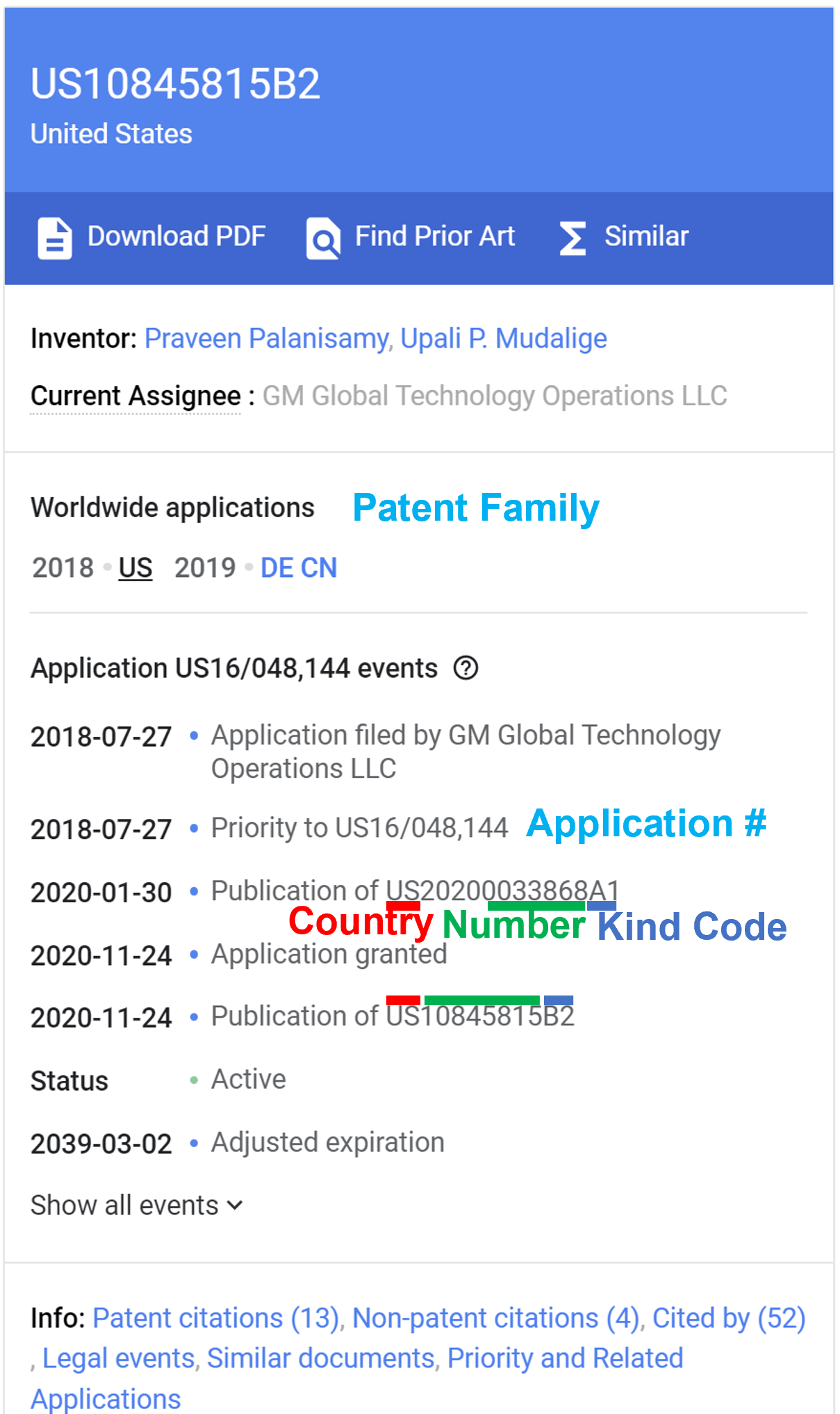
Patent Application Number: US 16/048,144
Patent Publication Number: US 2020/0033868 A1
Patent Grant Number: US 10,845,815 B2 ==> 10,845,815 is the patent number
The patent publication numbers follow this format: country code, a number, and a kind code
Kind code : version numbers for published versions of the patent application.
Every country has their own set of kind codes, but typically an A code (such as A1) represents a patent application, and a B code (such as B2) represents a granted patent
Patent Citations: Citations in the patent document itself
Patent Examiner’s Citations: Citations by the patent examiner
Patent citations are the citations that are listed in the patent document itself. These citations are listed in the patent document by the inventor(s) of the patent. Typically, the inventor(s) list these citations to show that their invention is novel and non-obvious compared to the prior-art. The patent examiner also lists citations in the patent document. These citations are called the patent examiner’s citations. Typically the patent examiner lists these citations to show that one or more claims in the invention is not novel or non-obvious compared to the prior-art.
Patent Document: A patent application or a granted patent.
Patent Family: A set of patents and patent applications that are related to each other. I.e. they protect the same or similar invention by the same inventors, typically filed in different countries.
One invention can be patented in multiple countries. For example, my patent claims in US 10,845,815 B2 are also patented in China and Germany. These patents are related to each other and form a patent family.
Tip: Through WIPO’s PCT (Patent Cooperation Treaty) application, one can file a single patent application in multiple countries. The PCT application is examined by the patent examiner in the International Searching Authority (ISA) and the International Preliminary Examining Authority (IPEA). The patent application is then filed in the countries that you choose. The patent application is then examined by the patent examiner s in those countries and then granted accordingly.
One patent can only have up to 20 claims. Some of the claims can be granted and some can be rejected.
Patent Classification Codes are used to classify patents based on the technology they cover. The patent classification codes are used to search for patents in a specific technology area. For example, one of the patent classification codes for my patent US 10,845,815 B2 is G06N 3/08 for “learning methods” as shown below: 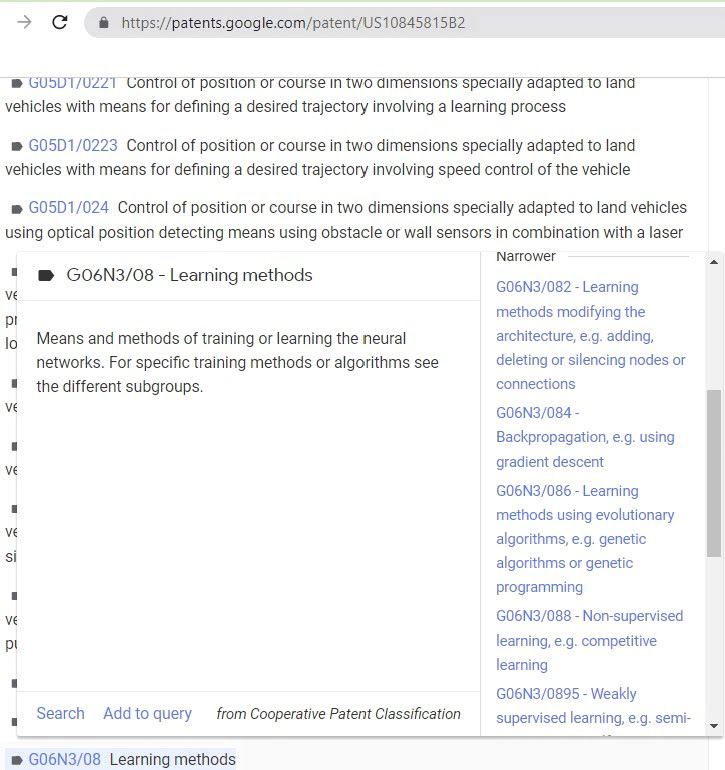
For a complete list, here is a link to the USPTO patent classification codes and WIPO’s International Patent Classification (IPC) page.
Google Scholar is a great and widely used service for scholarly profiles, citation counts and publication indexing. On the down side, the patent information in Google Scholar Profile is incomplete. Google Scholar profile automatically includes some patent documents and an incomplete patent citation count. For example, my Google Scholar profile, as of 2023-07-01, shows only 556 as my total citations count which includes 442 scholarly publication citations and 114 patent citations. But, my total citation count is more likely to be 442 (Scholarly citations based on Google Scholar profile data) + 479 (combined patent citations based on lens.org query data) = 921.
actually 114 + 442 = 556 + 1 = 557. The missing citation is from my patent US 10,845,815 B2 which is not included in the Google Scholar profile.
Harzing’s Publish or Perish is a great tool to get several citation metrics for scholarly publications. It is a free, cross-platform (Windows, Linux, MacOS) software program that retrieves and analyzes academic citations. It uses Google Scholar to obtain the raw citations, then analyzes these and presents various metrics and allows you to export the data in multiple formats (e.g. CSV, Excel, HTML, RTF, and PDF).
Google patents is a great resource if you know the patent/publication numbers to lookup. The URL format is straightforward for example: https://patents.google.com/patent/US10678252B2 where the last part is the patent or publication number. It has a nice side panel that shows the patent numbers and citations along with the Classification codes, Claims, Description and Drawings as shown below: 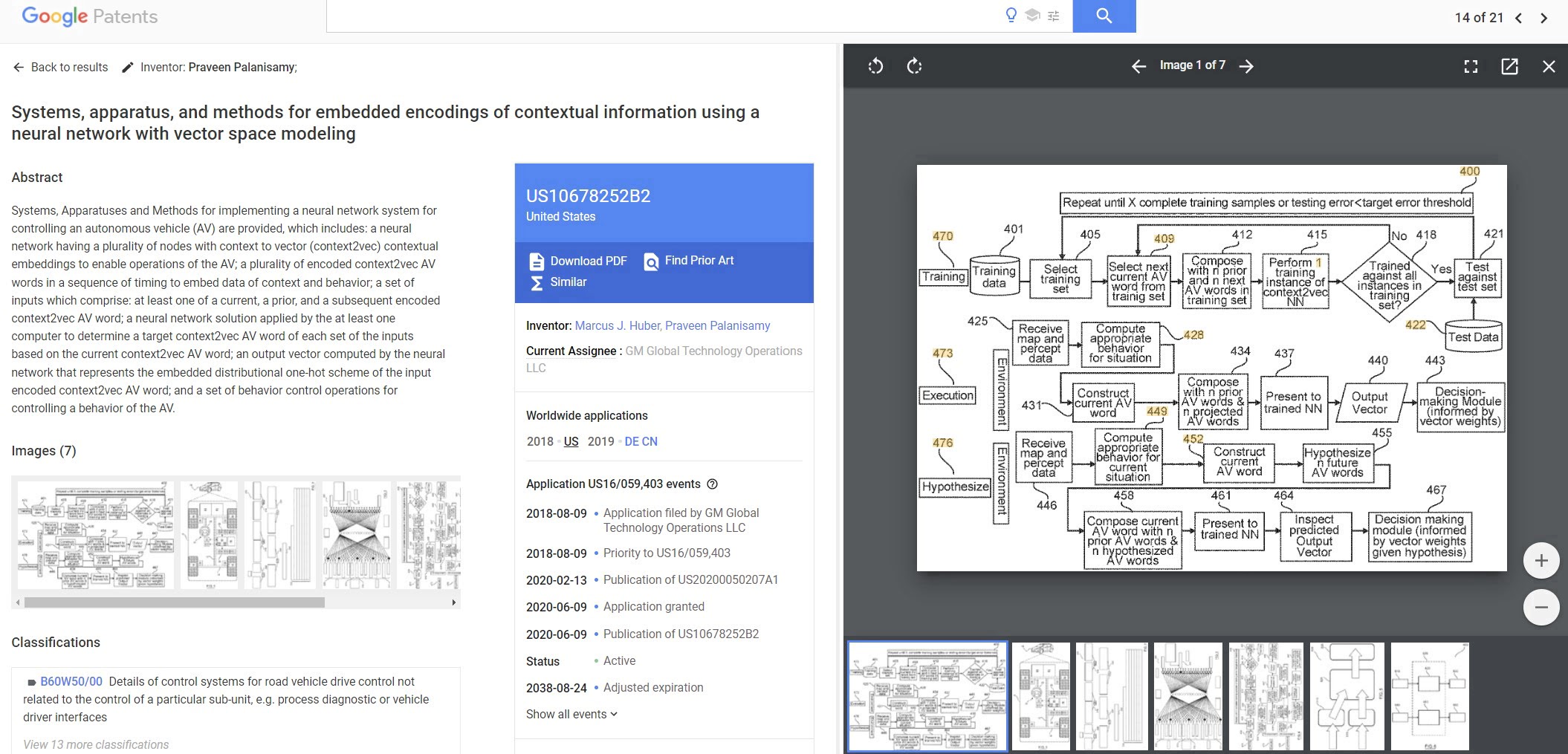
But, searching for patents on Google Patents didn’t yield complete results in my experience. For example, I couldn’t find my patent US 10,845,815 B2 on Google Patents search results by inventor name. I had to use the patent number directly to find it. The Google patent search results by intentor name returned an incomplete list of granted patents and patent applications.
Use lens.org for a more complete list of scholarly publications, patents, metrics, analysis and insights. Lens.org also has an extensive query, search and filter capability for both patents and scholarly publications. As an example, here is a link to my lens.org profile which shows a comprehensive list of my patents and scholarly publications along with the citation counts and other metrics. You can also search the database using queries, share queries, customize the dashboard and more. A sample screenshot of this search query is shown below: 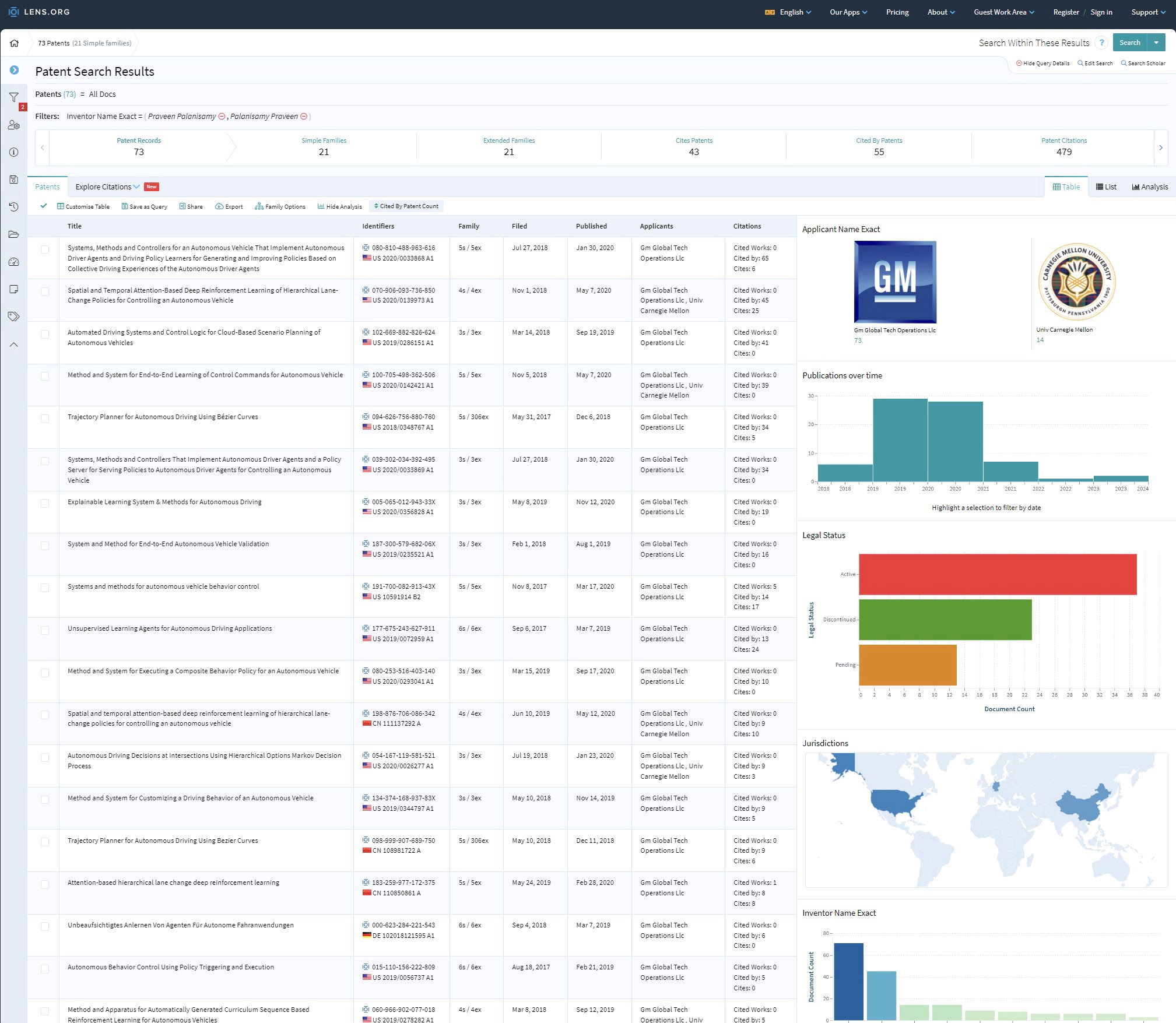
As you can see, the interface is quite customizable and extensible.
Tip: When you search/run a query for your publications and inventions, always search for both FirstName LastName and LastName FirstName. For example, I searched for “Praveen Palanisamy” and “Palanisamy Praveen” to get a complete list of my patents and scholarly publications. This is true for all the databases that I have used so far. It is due to the different citation format by standard bodies such as IEEE, ACM, etc.
Additionally, lens.org has a nice visualization and analysis tool for patents and scholarly publications. For example, the following visualization shows the number of patent documents by an inventor over the years along with the document type (application/granted) on a stacked bar chart. The visualization is interactive and you can hover over the bars to see the details.
More importantly, Lens allows exporting the data into various file formats including Vega-Lite Schema, CSV, JSON, etc. Here’s a sample Dashboard I created if you want to explore more: https://link.lens.org/pb13fMjKojj.
I discovered that my inventions have:
Google Deepmind’s “Multi-agent reinforcement learning with matchmaking policies” patent which was granted on 2023-04-11 cites 3 patents in total (including patent examiner’s citations) and one of them is my patent application US20200033868A1 which was granted in 2020-11-24. The fact that the invention by David Silver ( led AlphaGo, AlphaZero, etc.), Oriol Vinyals (led AlphaStar, AlphaCode) and Max Jaderberg cites my work, motivates me as my work is indeed impactful.
Here’s an interactive visualization of my top cited patents:
Obtained via lens.org using "citingPatentQueryId": "5bf5923b-042f-4974-b7ea-99089fdc1e97".
The number of patents citing a list of patents by an inventor, grouped by the citing organizations can be obtained via lens.org using a query. For example, here’s a list of the top 50 organizations that cite my patents:
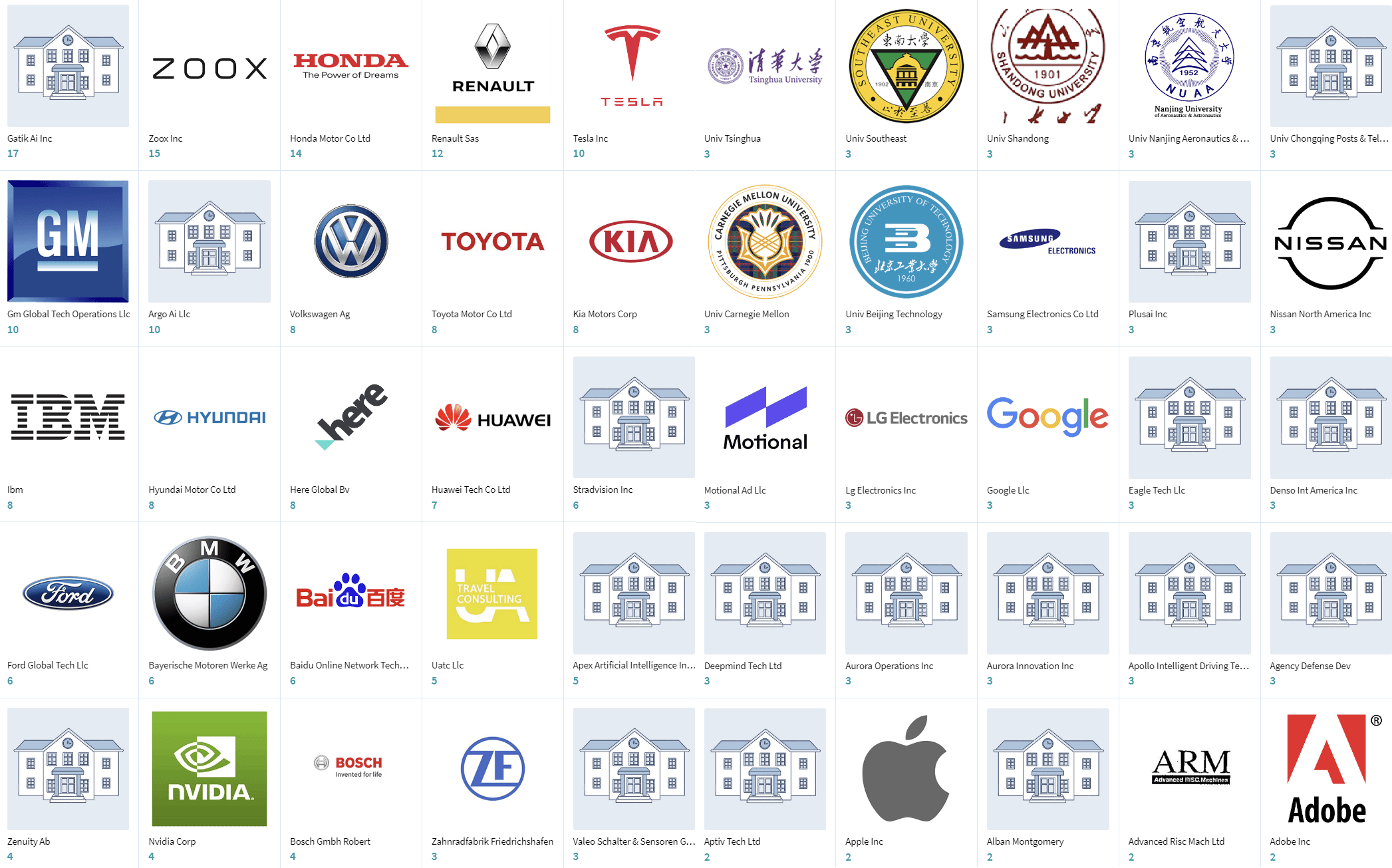 Obtained via lens.org, using this query.
Obtained via lens.org, using this query.
Going further, finding a statistical summary of the patent documents citing your patents is also easy with the data from lens.org. Following is an example of the statistical summary of the patent documents citing my patents (as of 2023-07-01), visualized using a stacked-bar chart:
Elon Musk has 10 patents filed as an inventor per Google Patents results, assigned to his companies Tesla, Zip2 and Neurallink. One of his patents filed on January 27, 2023 titled “Autonomous and user controlled vehicle summon to a target which includes former Tesla Director of AI, Andrej Karpathy as an inventor cites my patents “Systems and methods for autonomous vehicle behavior control” granted on March 17, 2020. This is a great motivation for me as my work is cited by Elon Musk’s patent.